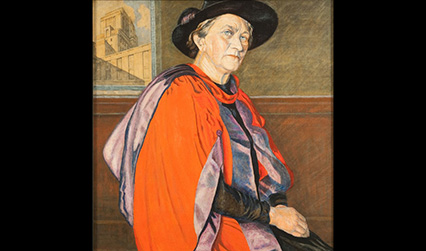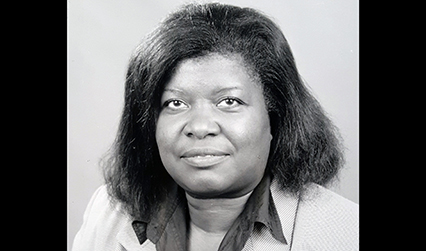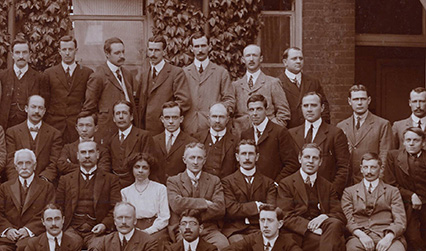It seems like only days ago that we launched our exhibition ‘This vexed question’: 500 years of women in medicine with the unveiling of a new portrait of Professor Dame Jane Dacre. But that was September 2018 and now it’s January 2019, and today is the last day that the exhibition is open to the public.
It’s fair to say that a lot of the RCP library, archive and museum team have found this exhibition particularly close to their hearts. That’s certainly the case for me: ever since we started the installation in the late summer I’ve been surprised by my own emotional reactions to the exhibits and stories revealed in the display cases and on the walls.

When leading tours of ‘This vexed question’ I’ve tried to bring different women to the fore on different occasions, to try and give all of them a fair hearing. But there are two that I’ve almost always found myself making sure to include: Flora Murray (1869–1923) and Louisa Garrett Anderson (1873–1943), represented in the exhibition by two portraits generously loaned by the Royal Free Hospital and University College London.
Murray and Garrett Anderson were personal and professional partners who shared their lives and work until Murray’s death in 1923. They were buried together, and their headstone reads ‘‘We have been gloriously happy’. Most famously, they set up and ran the Endell Street Military Hospital – staffed almost entirely by women – and were active in suffrage campaigns. The portraits were painted as a pair by Francis Dodds in 1928. Displaying them together today is a moving way to remember these two women whose determination and collaboration must have been formidable.
Having picked out my favourite exhibit(s), I’ve asked colleagues in the team to choose what most struck them in the exhibition. Their answers reveal something of the breadth of content we managed to include.
Kristin Hussey, senior curator chose the suffragette handkerchief made in Holloway prison in 1912, ‘because it shows what was at stake for women doctors who participated in the suffragette movement’. They not only risked prosecution and imprisonment, and serious health consequences from brutal force-feeding, but also their reputations and careers in the medical world. And yet, women doctors were active in the suffrage movement nevertheless.
Matthew Wood, exhibition officer picked out the oldest document included: a reproduction of a 13th century deed (British Library Cotton MS Domitian A III) in which two sisters, Solicita and Matilda describe themselves as ‘medica’, ie doctor. This document ‘shows how engrained ideas like “women couldn’t or didn’t practice medicine” aren’t really the case when you dig a bit deeper into the history.’
Natalie Craven, public programme officer chose the companion painting to my choices, showing an operation at the Endell Street Medical Hospital, painted by Francis Dodd in 1920/1. It’s different to the other artworks on display because it shows women at work, rather than in a formal portrait. Natalie finds ‘paintings of surgery are really fascinating. You normally don’t realise the gender of the people in them, and this is remarkable because the only man in the picture is the patient.’
Sarah Backhouse, exhibitions officer has picked something with personal resonance, an autograph album belonging to Beatrice Ethel Hirst, 1917–18. This was a loan from the Florence Nightingale Museum, London.
The history of nursing has always been significant for me, as my mother was a paediatric nurse for the NHS for 30 years. This autograph album really illustrates the important role nurses play in their patient's recovery. During the First World War, women nurses were the caring, nurturing female counterpoint to the injury and destruction inflicted by and upon male soldiers. This period really highlights the gender stereotypes that pervaded the medical world, in particular that nursing was considered perhaps the most acceptable sphere in which women could practise medicine. This autograph book, lent to use from the Florence Nightingale Museum, nearly made me cry. It's an example of the albums many nurses kept to collect contributions from patients, who used the opportunity to record their appreciation of the care they received. They include sketches, poems and jokes as well as messages from nursing colleagues. It's an incredibly intimate object that survives from a time of such turmoil.
Interaction with exhibition visitors, whether they’ve come to a guided tour, have left comments on our feedback wall, or have struck up conversation in the gallery space, has been a highlight of the exhibition for many of us. Abigail Buck, library assistant, picked out the suffragette handkerchief as a ‘tangible artefact from the time of the suffrage protests, something that shows what people created when conditions where really bad’. She also particularly remembered how much her own mum had enjoyed listening to the oral history and recorded quotations of opinions about women practising medicine at our listening posts. Exhibitions aren’t always about looking at things, and it was great to see people getting absorbed in the audio recordings.
Karen Reid, library manager looked way back into history and picked out a mythical figure included at the start of the exhibition. Panacea was a Greco-Roman goddess of universal remedy and daughter of Aesculapius, the god of medicine and healing. ‘I’d heard of Asclepius, but hadn’t heard of Panacea before, so she jumped out at me right away.’

Julie Beckwith, head of library, archive and museum services, has made a choice that illustrates the power that curators can exercise in their choice of what to display where in a building or public space.
I also have a soft spot for the portrait of Dorothy Hare. Some years ago I was told that she helped pregnant and unmarried women at a time when being pregnant and unmarried wasn’t socially acceptable. Knowing her portrait was hanging on a dark corridor at the back of the RCP building meant that not many people saw it and it seemed an indication that this was still something that shouldn’t be spoken about. Of course, Dorothy Hare did a number of things and it’s been good to see her given some prominence in the exhibition.

The exhibition has explicitly tried to include women from the distant past to the present, and to consider both historical and contemporary struggles that women faced and continue to face. Our departmental administrator, Corinne Harrison has chosen a photograph of Muriel Buxton-Thomas (1945–2016), a physician originally from Sierra Leone who was internationally recognised for her work in nuclear medicine, both research and clinical practice.
Including Buxton-Thomas in the exhibition highlights our incredible range of 20th century photographs, and the biographies collected by the RCP [in Munk’s Roll] that you just wouldn’t find anywhere else. It’s great to include someone working in nuclear medicine, the sort of specialty that isn’t always thought about. She’s a woman of colour, and they are particularly poorly represented in the RCP fellowship, so having her picture on display helps to show women of colour who come to the college that they are welcome here and that they can aspire to be a the next president.

Lowri Jones, collections officer, also chose a picture of a woman, but this is a silhouette created by Mark Conlin specifically for the exhibition to represent Ivy Woodward Dr Ivy Woodward (Mrs Ivy Haslam) (1877–1957), the first woman admitted as a member of the RCP, on 29 July 1909. We haven’t been able to trace any photographs or drawing of Ivy, so Conlin’s silhouette stands in for her, and all the other women whose images and stories have been lost from the historical record.
Firstly, it’s just really aesthetically pleasing. And when leading tours, it’s a really good way to get people to think about what’s not there. It’s hard to visualise “what’s missing”, but this is a good way to represent that visually and to illustrate one of the key themes of the exhibition, ie everything that hasn’t been recorded about women over history. It’s a big contrast to all the photographs we do have of men, and shows how great it would be if we did have images of all the women in the exhibition, and if we got to see them in professional settings rather than looking decorative.
Our assistant archivist, Felix Lancashire, picked an archival document generously loaned to the exhibition by Lambeth Palace Library. It’s a series of testimonials written about Elizabeth Moore from Market Harborough, used to prove her abilities in medicine so that she could be licensed to practise by the Archbishop of Canterbury. These are essentially job references, and it’s very easy to empathise with Moore as she went about collecting them. Felix is struck by ‘how administrative documents can reveal individual people’s personal stories and relationships between people. You can imagine her having to ask her patients to write a reference for her. Was she embarrassed about having to go round asking everyone?’
Exhibition guest curator, Briony Hudson, chose a related item, also loaned by Lambeth Palace Library, Jane Pemell’s personal testimony on her licensing document from the Archbishop.
My favourite is the testimonial written by Jane Pemell in support of her application to be registered by the Church of England as a medical practitioner in 1685. To have read about her in an article, followed up with the original document in Lambeth Palace Library, and then borrowed it to be in the exhibition is a great illustration of how the exhibition came together so successfully. I find the power of reading her strong words expressing her need to practice in order to support her family, written in her own handwriting, almost overwhelming, and for me it encapsulates our twin aims of finding themes that resonate over time, and highlighting the individual voices of remarkable medical women.
This is just a handful from the exhibition’s exhibits, and from the blog posts we’ve published over the last four months which highlight even more women active in medicine.

To end, there’s a good news story: when we started researching ‘This vexed question’, we couldn’t for a long time find a photograph of Dossibai Patell (Mrs Dossibai Dadabhoy) (1882–1960), the first the first woman licentiate of the RCP the first woman member of the Royal College of Surgeons of England, admitted to both in 1910. We managed to track one down at the London School of Hygiene & Tropical Medicine, and now Patell also has her own Wikipedia page. Piece by piece, the stories of medical women are being filled in and recorded.
Katie Birkwood, rare books and special collections librarian
